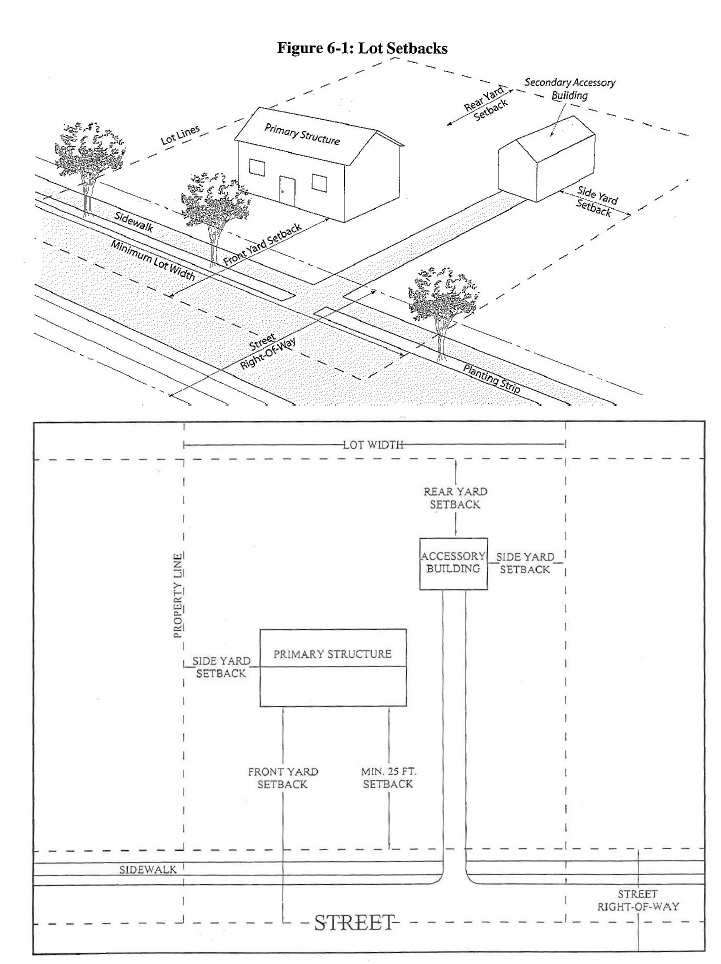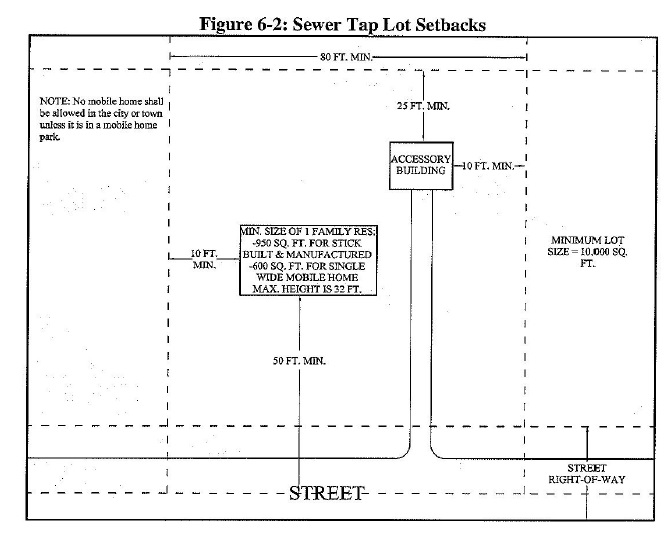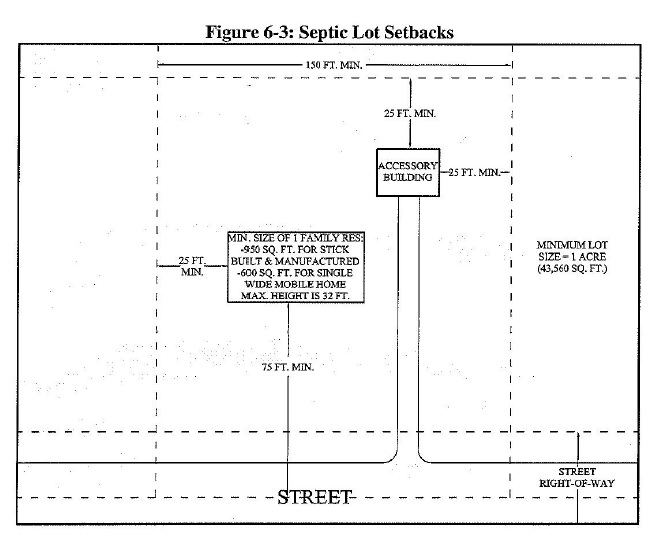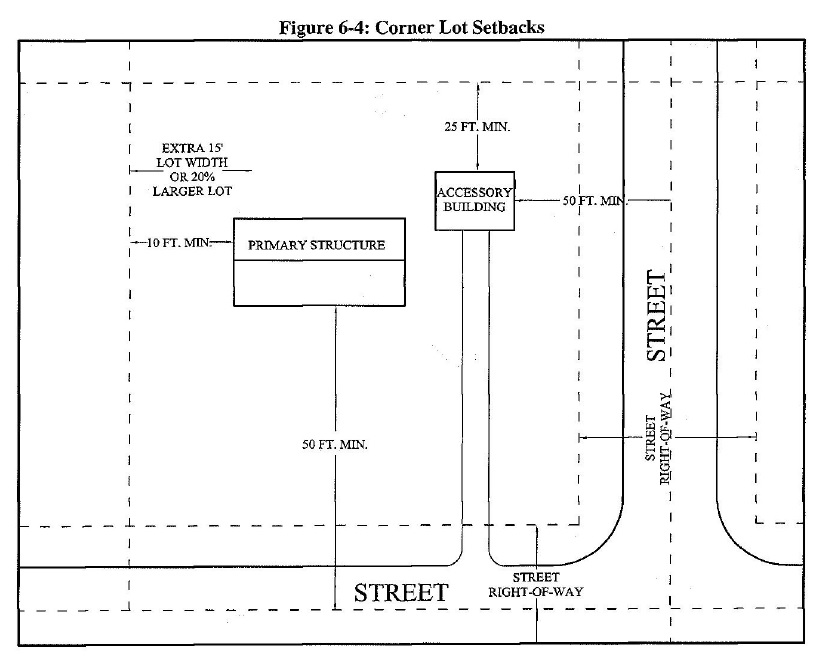(A) Introduction. For documentation of issues addressed in this chapter, See Jennings County Comprehensive Plan, Chapter III: “Housing” and Chapter VI: “Land Use,” November 1, 1994.
(B) Establishment of residential zoning districts. The following residential zoning districts are established in the county and are abbreviated as indicated. Land within the county is classified, divided and zoned into said districts as designated on the zoning maps, which maps are incorporated herein by reference and made a part of this chapter.
Residential | Abbreviations |
Residential Multiple-Family | R-MF |
Residential Resorts | R-R |
Residential Single-Family | R-1F |
Residential Two-Family | R-2F |
(1) Residential Single-Family (R-1F) Districts are designed for detached single-family dwellings.
(2) Residential Two-Family (R-2F) Districts are designed for two-family dwellings commonly known as “duplexes or doubles.”
(3) Residential Multiple-Family (R-MF) Districts are designed for multi-family residences, such as apartments, or any type of residential building designed to accommodate more than two families.
(4) Residential Resort (R-R) Districts are designed for resort living.
(C) Residential regulations. The following regulations shall apply to all land within the residential districts.
(1) Regulation conformation after the effective date of this chapter.
(a) With the exception of legally established non-conforming uses, no land, building, structure, premises or part thereof shall be used or occupied except in conformity with these regulations and for uses permitted by this chapter.
(b) No building, structure, premises or part thereof shall be constructed, erected, converted, enlarged, extended, reconstructed or relocated except in conformity with these regulations and for uses permitted by this chapter. (For steps on how to obtain a building permit, refer to § 154.030.)
(c) Provided, however, legally established non-conforming uses may be reconstructed if damaged or partially destroyed by fire or other disaster when such damage destruction does not exceed two-thirds of the gross floor area of the structure or facilities affected.
(d) Provided, however, any previously officially recorded, platted lot having less than the minimum lot area and/or minimum lot width required by the applicable residential district regulations of this chapter of a one-family dwelling, shall be deemed an exception to such minimum lot area requirement, and a one-family dwelling may be constructed thereon provided all other requirements of this chapter, including minimum yard and setback requirements, shall be met.
(e) Provided further, however, any legally established non-conforming use, public elementary, junior high or high school (including any structures, facilities and parking areas accessory thereto) may be constructed, erected, converted, enlarged, reconstructed or relocated for such public elementary, junior high or high school use on the same lot or parcel.
(2) Performance standards. All uses established or placed into operation after the effective date of this chapter shall comply with the following performance standards. No use in existence on the effective date of this chapter shall be so altered or modified as to conflict with these standards.
(a) Vibration. No use shall cause earth vibrations or concussions detectable beyond the lot lines without the aid of instruments.
(b) Smoke, particulate matter, noxious matter. No use shall emit smoke of a density exceeding that of a normal residence, nor burn any materials or chemicals other than standard heating fuels such as fuel oil, propane or natural gas, with the exception of burning wood in approved residential places.
(c) Odor. No use shall emit across the lot lines odor in such quantity as to be readily detectable at any point along the lot lines and as to be detrimental to or endanger the public health, safety or welfare or cause injury to property.
(d) Sound. No use shall produce sound in such a manner as to endanger the public health, safety or welfare or cause injury to property. Sound shall be muffled so as not to become detrimental due to intermittence, beat frequency, shrillness or vibration.
(e) Heat and glare. No use shall produce heat or glare creating a hazard perceptible from any point beyond lot lines.
(f) Junk automobiles (vehicles). Vehicles not properly licensed nor in running condition and parked at a residence more than 30 days may be removed from the property with the notification by certified mail to the vehicle owner. These vehicles will be towed at owner’s expense to a holding area for 30 days and then disposed of to a legal salvage yard. Notification and removal will be under court and police supervision. A show cause hearing will not be held for these violations.
(g) Unnecessary clutter. No one shall be permitted to heap, litter or strew in a confused and disorderly manner, any material or objects on property owned, leased or rented for residential purposes.
(h) Waste burning. No use shall accumulate within the lot or discharge beyond the lot lines any waste matter, whether liquid or solid, in violation of the applicable standards and regulations of the Department of Environmental Management or in such a manner as to endanger the public health, safety or welfare or cause injury to property.
(i) Leaf burning. Burning of leaves shall be regulated by the incorporated community. In unincorporated areas, however, burning of leaves shall be permitted in residential zones after dawn and before dusk.
(j) Yard sales. Each residential household is permitted three yard (garage) sales per calendar year, not to exceed three days each. Time established will be sunrise to sunset, and items not sold must be cleared from the residence within a 24-hour period.
(3) Blight. Land that is in a dilapidated, unsafe and unsightly condition. No one shall be allowed to keep their property in the following conditions:
(a) Unnecessary clutter.
(1) Heap, litter, or strew, in a confused and disorderly manner, any material or objects on property owned, leased, or rented for residential purposes;
(2) Discarded household appliances, furniture, tires, motor and electric vehicle parts, tools, lawn equipment, construction material, scrap metal, trailers, hauling equipment, machinery, barrels, grills, plastic, and/or Styrofoam.
(b) Missing or boarded up windows and/or doors;
(c) Extreme uncontrolled vegetation in, on, or around the base of the home such as weeds, vines, trees, grass, etc.;
(d) Exterior deterioration or decay such that it leads the property to be unsafe, unhealthy, or impairs the property values. Specifically gutters that have fallen or are falling off the structure, eaves, soffits, decks, porches, wall or roof coverings that do not provide adequate weather protection or are completely missing;
(e) Unhealthy living conditions including, but not limited to, mold, vermin, pigeons, feces and other harmful conditions
(4) Residential development standards.
(a) Development standards in residential districts fall into two categories, dictated by the type of sanitation provided for the residences, either by the provision of sanitary sewers or provision of septic tank disposal.
(b) Multiple-family residences must have sewer service and are not permitted to use septic tanks. R-MF special development standards. R-MF Districts shall meet the following development standards in addition to those shown above.
1. The lot area shall be a minimum of 3,000 square feet for every living unit.
2. Buildings shall occupy not more than 30% of the lot area.
TABLE 6-1 RESIDENTIAL LOT LAYOUTS
R-1F Septic | R-1F Sewer | R-2F Septic | R-2F Sewer | R-MF Sewer |
R-1F Septic | R-1F Sewer | R-2F Septic | R-2F Sewer | R-MF Sewer | |
Lot Size | |||||
Minimum lot (5) | 1 acre | 10,000 sq. ft. | 2 acres | 15,000 sq. ft. | 12,000 sq. ft. |
Minimum lot width (1)(5) | 150 ft. | 80 ft. | 250 ft. | 100 ft. | 150 ft. |
Flag lot width (at road) | 50 ft. | 50 ft. | 50 ft. | 50 ft. | 50 ft. |
Off-Street Parking (3) | |||||
Minimum spaces | 2 | 2 | 4 | 4 | 1.5 per unit |
Setback & Yards | |||||
Minimum front yard setback (2)(6) | 75 ft. | 50 ft. | 75 ft. | 50 ft. | 60 ft. |
Flag lot (8) | 50 ft. | 50 ft. | 50 ft. | 50 ft. | 50 ft. |
Minimum rear yard setback (6) | 25 ft. | 25 ft. | 25 ft. | 25 ft. | 20 ft. |
Outbuilding (7) | 10 ft. | ||||
Minimum side yard setback (6) | 25 ft. | 10 ft. | 50 ft. | 15 ft. | 10 ft. |
Outbuilding (excluding swimming pool) | 10 ft. | ||||
Structure Size (4) | |||||
Maximum height | 32 ft. | 32 ft. | 32 ft. | 32 ft. | 40 ft. |
Minimum floor area | 950 sq. ft. | 950 sq. ft. | 1,700 sq. ft. | 1,700 sq. ft. | 600 sq. ft./unit |
(1) Lot width is measured at the building line. (2) Any side of a lot that faces a public street or public right-of-way shall be considered a front and shall have appropriate setback, measured from the centerline of the road or street. Under no circumstances shall the front yard setback be less than 25 feet from the right-of-way line. (3) Off-street parking spaces as defined in Chapter 2, Section C. (4) No singlewide mobile homes are permitted inside the Town of Vernon or City of North Vernon. (5) Corner lots shall be 15 feet wider than the minimum required or 20% larger in total area. (See Figure 6-4 for visual of a corner lot.) (6) Any lot that is adjacent to a state highway shall be 1.5 times the standard setback for any front that faces the highway. (7) Outbuilding setbacks are for all lots including flag lots. (8) The front yard setback shall begin at the point where the property becomes at least 150 ft. wide. | |||||
(Refer to figure 6-1 through 6-4 for graphical representations.) Fences in any residential district shall not exceed six feet in height as long as it does not obstruct view of public ways and in a way that promotes and maintains essential values: public safety, protection of individual property rights, and quality life for residents. The depth to width ratio of any residential lot may not exceed a maximum of 6 to 1 or a minimum of 2/3 to 1. (Where 1 is the lot width in both cases) (See Figure 4-1: Depth to Width Ratio for an example.) | |||||




(D) Special regulations for mobile homes, recreational vehicles, travel trailer and tents.
(1) Mobile homes, as defined in the definitions section, shall comply with all regulations for residential districts and shall comply with all following special regulations for mobile homes.
(2) Every mobile home must retain a HUD certification tag, verifying that the home was constructed in accordance with the regulations of the U.S. Department of Housing and Urban Development.
(3) Every mobile home shall meet state requirements for tie-downs and underpinnings.
(4) Single-wide mobile homes that are not in mobile home parks must have the area under each unit, surrounded by a permanent skirt of sufficient construction so as to cover the area between the bottom of the unit and the top of the base or ground. Any double-wide mobile home over 16 feet by 80 feet shall be on a permanent foundation.
(5) Trailers and mobile homes shall not be permitted in any district as accessory buildings.
(6) Mobile homes shall not be parked or stored in any district, except at a permitted trailer sales establishment. Mobile homes, trailers or recreational vehicles shall not be occupied for dwelling or lodging purposes except in an approved mobile home park. Travel trailers are not suitable for use as residences. A mobile home, recreational vehicle or travel trailer, belonging to a guest of the occupant of a dwelling in an agricultural district or residential district, may be parked and occupied for lodging purposes on the same lot as the dwelling for not more than 72 hours in any 30-day period.
(7) Trailers, recreational vehicles or mobile homes may be used as temporary offices or storage space incidental to construction of a building development for a period of time as such construction is actively undertaken provided the trailer or mobile home is located on the same lot as the building development.
(8) Tents shall not be erected, used or maintained for dwelling, lodging or other purposes, except as regulated herein.
(E) Special uses - residential districts.
(1) Mobile home park.
(a) Mobile home park shall be a special use permitted only in R-MF districts.
(b) A mobile home park must be on a lot no less than five acres in area, with a minimum road frontage of 300 feet. No mobile home shall be nearer than 50 feet to a county road. There shall be a minimum of two entrances to a mobile home park, unless a different number is approved by the Area Plan Commission.
(c) Each mobile home site shall be no less than 5,000 square feet in area and no less than 50 feet in width, with an average of all sites to be no less than 5,000 square feet in area. Each mobile home lot shall have a minimum 24 feet setback from mobile home park streets and minimum ten feet side and rear yards.
(d) A mobile home park may include accessory uses, buildings or structures such as a community center, laundry facilities, offices and the like, provided that they are located, designed and intended to serve only persons living in the park, and provided that such buildings shall not occupy more than 10% of the total area of the park, and provided that such uses shall present no visible evidence of the commercial nature of their uses to areas outside the park.
(e) There shall be a park or playground area equal to at least 8% of the park area.
(f) Sanitary sewage, storm sewer and water systems, service drives, off-street parking equal to at least two parking spaces for each mobile home, grading and landscaping, buildings and other improvements shall be constructed in accordance with development plans and specifications approved by the Board of Zoning Appeals. No on-street parking is permitted.
(g) Street construction shall meet the standards of the Subdivision Control Ordinance of the county and/or other governmental unit in which the mobile home park is located. Mobile home park streets shall be paved with portland cement concrete or bituminous concrete. Such streets shall be a minimum of 24 feet wide.
(h) A paved sidewalk shall be installed on at least one side of each mobile home park street. The minimum width of such sidewalks is four feet.
(i) Surface drainage as approved by the Area Plan Commission shall be installed and maintained by the applicant or his or her successor in title. The Area Plan Commission may require curbs and/or gutters in mobile home parks where, in the opinion of said Commission, drainage of surface water is insufficient to properly carry such surface water.
(j) Outside storage is prohibited. Applicant/developer shall provide minimum storage space and requirements for storage buildings in the covenants.
(k) Each mobile home shall be installed in accordance with Cabo One and Two Family.
(1) All exterior lights shall be located and shielded to prevent direct illumination outside the park. All refuse containers shall be screened from view. A dense greenbelt of evergreen trees or shrubs, not less than six feet in height, shall be located and maintained along all park boundaries.
(m) Prior to issuance of an improvement location permit, an applicant must file with the Director a letter from the State Board of Health evidencing approval by such Board and compliance with the requirements of such Board.
(2) Bed and breakfast. Operation of a bed and breakfast, as defined in § 154.008, within a residential district shall be subject to all following regulations for a bed and breakfast.
(a) There shall be on the premises a minimum of one parking space per rental unit.
(b) The bed and breakfast must meet state approved standards for lodging, food preparation, food service and any other state-regulated activities conducted in the operation of the bed and breakfast.
(c) A single unlighted business sign, not larger than one square foot, may be posted on the premises.
(d) This is a special use within residential districts and will be revoked if the requirements are violated.
(3) Home occupation or home business. Operation of a home occupation, as defined in § 154.008 within a residential district shall be subject to all regulations of residential districts and shall be subject to the following regulations for a home occupation.
(a) A single unlighted business sign, not larger than five square feet, may be posted on the premises.
(b) The business must provide off-street parking for clients/customers, as well as for every employee. At such time as the parking needs of the business exceed the parking available on the residential premises, the business shall no longer be considered a home occupation and must operate in a commercial district.
(c) A home occupation shall not employ more than two non-family employees. Businesses with more than two non-family employees must operate in a commercial district. Off-street parking shall be provided at one space for every employee plus two additional spaces for customers, clients and suppliers.
(d) A home occupation/business that is located in a building not attached to the residence shall be located within 100 feet and on the same property as the residence.
(e) A home occupations/business permit shall be revoked if any of the said requirements are violated. If a property changes ownership or the business type changes, the owner must re-apply for a home occupations/business permit.
(4) Residential facility for the mentally ill. Any residential facility for the mentally ill, including group homes, shall be required to submit documentation showing their geographic location by map or address. This information will be used to determine if the property is at least 3,000 feet from any other facility for the mentally ill.
(F) Violation enforcement and penalties.
(1) Enforcement.
(a) Any person, firm, or corporation who violates the ordinances of the Jennings County Code shall be liable and subject to the enforcement and penalties of the Jennings County Area Plan Commission (APC).
(b) The enforcement and penalties for violations to the Jennings County Zoning Ordinance shall adhere to the following structure:
1. Violation classification.
a. A-Level infraction (low);
b. B-Level (medium);
c. C-Level (high).
2. A-Level. Violations that can be remediated quickly and by nature are not extremely detrimental to the safety and well-being of the owners, tenants or general public. Ordinances include:
a. Grass Ordinance violations;
b. Extreme overgrowth of vegetation;
c. Trash, litter, or debris;
d. Unoperable/unlicensed vehicles.
3. B-Level. Violations that are more serious in nature and place the homeowner, tenant or general public in a safety or health hazard. These violations can be remedied in a 30- to 60-day period so long as the violator is actively working with the APC to resolve the problem. Ordinances include:
a. Blight.
4. C-Level. Violations that are extremely severe to the point that the property is condemnable and/or uninhabitable. These properties are typically, but not always, vacant or abandoned. Ordinances include:
a. Extreme deterioration such as holes in roof, structurally unsafe, extreme health hazard due to rodents, mold, and or sewage;
b. Violations to the Animal Control Ordinance;
c. Fire damage of longer than 60 days.
(2) Violation enforcement process per classification.
(a) A-Level.
1. Letter with 15 days to resolve violation or to contact APC Office to address the issue;
2. Director has discretion to allow more time or connect them with resources if they qualify;
3. Attorney files legal action after 15 days if issue is not resolved or more time has not been granted by the APC Director;
4. If case is not dismissed prior to the court hearing, a fine of no less than $100 and no more than $1,500 will be assessed at the court hearing;
5. If fine is not paid, then it will be assessed to the property taxes.
(b) B-Level.
1. Letter with 30 days to resolve violation or to contact APC Office to address the issue;
2. Director has discretion to allow more time or connect them with resources if they qualify;
3. If they do not comply within 30 days or the APC director has not allotted them more time, then they will be brought to the next APC "Show Cause" hearing;
4. If case is not dismissed prior to the court hearing, a fine of no less than $100 and no more than $1,500 will be assessed at the court hearing;
5. If fine is not paid, then it will be assessed to the property taxes.
(c) C-Level.
1. Letter with 30 days to resolve violation or to contact APC Office to address the issue;
2. Director has discretion to allow more time or connect them with resources if they qualify;
3. Attorney files legal action after 30 days if issue is not resolved or more time has not been granted by the APC Director;
4. If case is not dismissed prior to the court hearing, a fine of no less than $100 and no more than $1,500 will be assessed at the court hearing;
5. If fine is not paid, then it will be assessed to the property taxes.
(d) Repeat violators.
1. Same process as above but starting fines will be increased at a price determined by the APC Director;
2. Level-B violations will not go to "Show Cause", but rather legal action will be filed with the court if they don't comply within the 30 days;
3. On any violation the Director has the discretion to bring any case to the APC Board at their "Show Cause" meetings.
(Ord. passed 9-1-2006; Ord. passed 7-9-2007; Ord. 04, 2008, passed 6-23-2008; Ord. 2021-03A, passed 3-18-2021) Penalty, see § 154.999